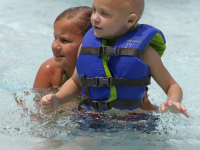Water Safety Tips For The Summer
Summer fun can turn to tragedy in an instant. Now is a good time to brush up on how to keep your family safe while enjoying the pool or beach this summer
Swim Safety Tips
- Never leave children unattended near water. Avoid distractions and don’t drink alcohol when supervising.
- Teach children how to swim.
- Learn CPR.
- Have children use life jackets approved by the U.S. Coast Guard. Inflatable pool toys are not safety devices.
- Get out of the water if you see lightening or hear thunder.
- Keep a cell phone handy in case of emergency.
- If your child is missing, check the water first! It only takes a few moments to drown
At the Pool:
- If you own a pool, make sure it is appropriately secure so children cannot enter alone. According to the American Red Cross, many children who drown in a pool were out of sight for less than five minutes and have one or both parents nearby.
- Keep safety equipment near the pool. This should include reaching equipment, life jackets, first aid kit, and cell phone.
- Swim only when lifeguards are on duty. In private pools, always have a swim buddy.
At the Beach:
- Swim in areas designated as safe.
- Swim only when lifeguards are on duty.
- Check weather conditions before swimming.
- Wear a life jacket when going out on a boat or participating in water sports.
What Beach Flags Mean
According to the National Weather Service, different beaches may use different colors for warnings, but these are the most common:
- Green: calm conditions
- Yellow: medium hazard
- Single Red: high hazard such as strong surf or currents
- Double Red: beach is closed to the public
- Purple: Flown with either Red or Yellow: dangerous marine life, not including sharks
Watch Out for Rip Currents
Rip currents are narrow channels of fast-moving water that can occur at any beach that has breaking waves, including the Great Lakes. Rip currents can move as fast as eight feet per second. The National Oceanic and Atmospheric Administration reports that about 100 people are killed by rip currents every year in the U.S.
Don’t fight a rip current by attempting to swim straight back to shore. This can cause overwhelming fatigue in a very short time. Swim parallel to shore and try to swim back at an angle.
Rip currents are not always easy to spot, but signs of rip currents may include:
- a line of seaweed, foam, or debris that moves steadily out to sea
- differently colored water past the surge zone
- a channel of choppy or churning water
- a break in incoming wave pattern
<
